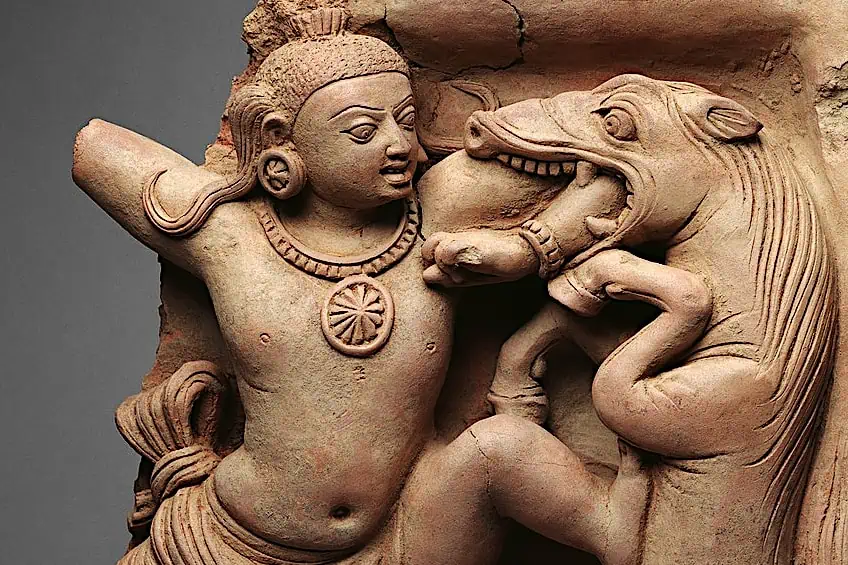Indian Art – Spectacular Masterpieces from the Subcontinent
A fusion of narrative, mythology, spirituality, and vibrant creativity describes the world of Indian art that is admired by many across the world for its unique and distinct style. For centuries, the Indian arts have pioneered some of the most visually stunning and intricate works across the mediums of painting, sculpture, and textile art, while showcasing the diversity of the country’s culture and artistic prowess. In this article, we will examine the best of Indian art, from the treasures of ancient Indian art to unique paintings and sculptures inspired by mythology. Keep reading for more about the rich artistic heritage of India!
Contents
- 1 Exploring the Vibrant World of Early Indian Art
- 2 Popular Traditional Indian Art Forms
- 3 Cultural and Religious Influences on Indian Art
- 4 Examining Art from India
- 4.1 Krishna Killing the Horse Demon Keshi (c. 5th Century CE)
- 4.2 The Ajanta Cave Paintings (c. 5th – 7th Century CE)
- 4.3 Preaching Buddha (c. 8th Century CE)
- 4.4 Prince Akbar and Noblemen Hawking, Accompanied by His Guardian Bairam Khan (c. 1555 – 1558)
- 4.5 Jahangir Watching an Elephant Fight (c. 1605)
- 4.6 Portrait of William Fullerton of Rosemount (c. 1760 – 1764)
- 4.7 Great Indian Fruit Bat (1777 – 1782)
- 5 Famous Indian Artists
- 6 Frequently Asked Questions
Exploring the Vibrant World of Early Indian Art
Art from India boasts a fusion of unique worldviews and art-making techniques that borrowed and adapted concepts and narratives from surrounding Asian diasporas. India’s artistic heritage is deeply connected to the many religious and cultural belief systems that governed the different societies within India since the South Asian Stone Age.
India holds around 1,300 rock art sites that include significant archaeological artifacts and sculptures of ancient civilizations as well as paintings that date back more than 10,000 years ago.
Important ancient cave art sites and rock shelters include the 750 UNESCO World Heritage sites known as the Bhimbetka rock shelters and many sites around the Vindhya mountain range, which include paintings and drawings of India’s earliest civilizations, with valuable information on human life, hunting, and animals. The earliest types of pigment used to create ancient Indian cave paintings were produced from a mineral called geru, which helped artists create a red wash and is a form of Hematite.

Over time, art saw a development through civilizations in the Indus Valley from 3300 BCE who produced small-scale works and figurine sculptures of domestic animals. Carved seals bore the illustrations of early figurative work made of steatite, which was used as personal adornments. Artists also produced small female figurines posed in dancing positions and were created using gold, stone, and terracotta.
As the centuries progressed, Indian art saw influences from early Vedic religion and the Copper Hoard culture, which gave rise to elements of anthropomorphism in Indian art.
Below, we will explore the most significant art forms that emerged in Indian art along with their defining contexts and artworks that solidify India’s artistic heritage.
Popular Traditional Indian Art Forms
As Indian art unfolded over time, artists began developing their hands in many art forms, including pottery, architecture, painting, textiles, and jewelry making.
Traditional art forms such as silk weaving and performances such as the Kathak dance form foundational aspects of ancient Indian art that provide insight into the way that art infiltrated culture.
Below are some of the most popular traditional Indian art forms from Indian art history that showcase the skill and vision of India’s finest artists.
Silk Weaving
Silk weaving is a 2,000-year-old Indian art form that involves the rearing of silkworms and the extraction of silk from the worms’ cocoons. Indian silk weavers were highly skilled artists who used different techniques to create stunning floral and geometric patterns in their works. Techniques such as the Jamdani method and the Patola method were common in traditional processes. The Patola technique involves the process of tie-dying the silk before weaving to produce intricate geometric designs.
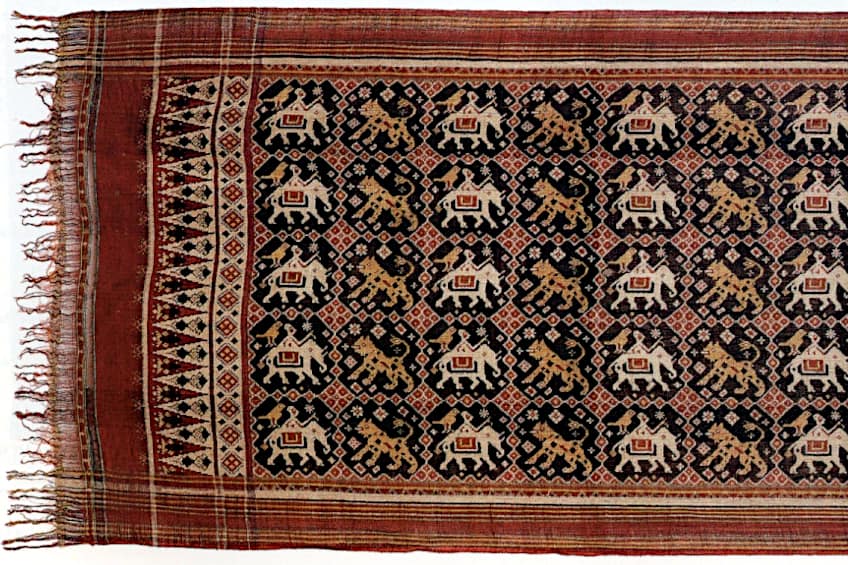
The art of silk weaving was incredibly significant in ancient Indian societies since silk was a symbol of royalty and was often used in important ceremonies. The glamorous nature of the silk fabric was embellished with other decorative elements to create fabulous silk sarees that showcased the refined designs of artists and the elegance of the wearer. Women would wear silk sarees for special events such as weddings to an opulent effect.
The production of silk was also crucial to the development of the Indian economy since many communities relied on it as their source of income and livelihood.
Across India, weaving centers were built where artists gathered to create specific designs using specific techniques, which were passed on through generations to preserve India’s silk heritage. Silk weaving remains one of the country’s Contemporary art forms as it incorporates methods from the past with new designs to attract a larger audience while preserving the quality of the practice.
Painting
Ancient Indian paintings provide a wealth of information on the development of artistic styles and subjects in Indian art. Painting, as an art form, was used to demonstrate an artist’s knowledge and mastery of color, composition, and storytelling while actively creating works that would encapsulate historical moments in India’s history. The Ajanta caves in Maharashtra are a world-famous UNESCO site that is renowned for their Buddhist paintings that date back to the 2nd century BCE. These paintings portray scenes from the Jataka myths and present a vibrant display of religious imagery through natural pigments and mineral dyes.
The Bagh Caves in Madhya Pradesh also house some of the most exquisite paintings you will ever come across and date between the 5th and the 7th centuries CE.
The wall paintings of the Bagh Caves are profound to religious followers of the Buddhist and Hindu faiths since they contain episodes from the lives of Hindu and Buddhist deities. The unknown artists used a fresco technique combined with organic pigments to create the scenes that also exhibit a strong focus on color and line.
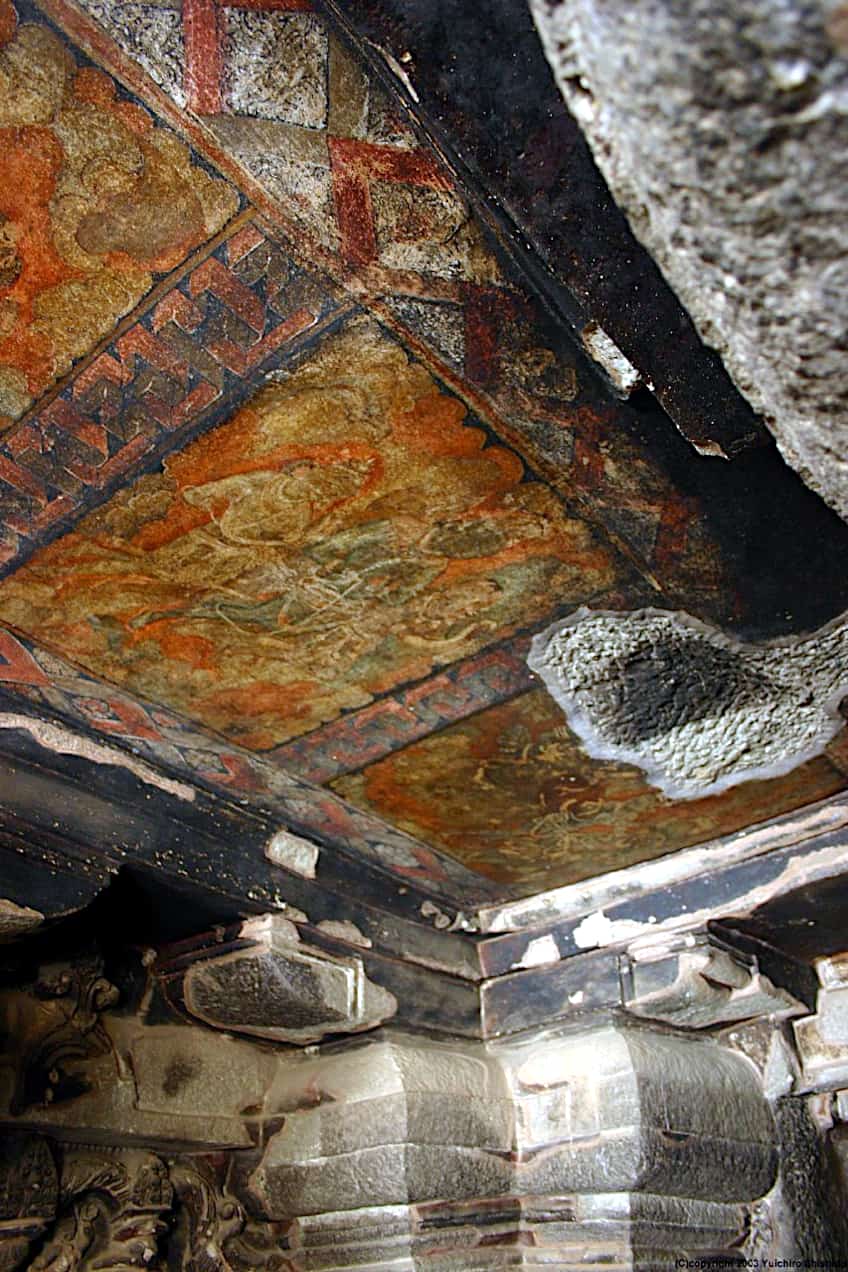
Significant artistic sites with Indian paintings from the 6th to the 10th century CE also include the Ellora Caves in Maharashtra, which demonstrate a fusion of Jain, Hindu, and Buddhist art styles. The Indian paintings of the Ellora Caves represent celestial beings, deities, and mythological scenes rendered in delicate brushwork and intricate detail. Painting was most rife during the reigns of Akbar, Jahangir, and Shah Jahan, each of whom appreciated the art form. A ban on painting was placed under the reign of Shah Jahan’s son, Aurangzeb, whose ban on art and music in 1680 resulted in a decline in Mughal patronage.
For centuries, Indian paintings evolved through the cultural adaptation of Indian art styles from various sources, including the production of miniature paintings in the Mughal era under the patronage of Rajput and Mughal leaders.
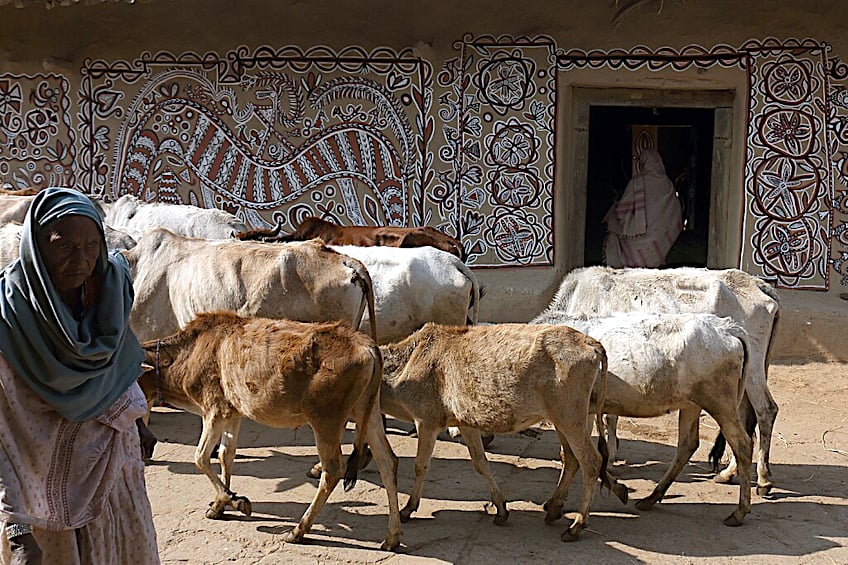
Other styles seen in art from India painting are defined by the Rajput, Deccan, Pahari, and Kangra painting styles. Western influences in Indian art were seen during the arrival of European colonizers in the 16th century, which led to hybrid styles and the development of the Bengal School of Art in the early 20th century. The Company style of painting, also known as Patna painting, also emerged as an Indo-European style of painting produced by Indian artists for European patrons. Other popular Indian painting styles include Kalamkari paintings, Kalamezhuthu art, Bhil paintings, Sura paintings, and Khovar and Sohrai paintings.
Sculpture
Ancient Indian sculpture evolved over a vast period, from 3000 BCE to the Medieval era, which saw the development of different sculpture techniques. Indian sculptors used methods such as carving, modeling, and casting to produce sculptures with diverse themes and subjects. From materials like bronze, terracotta, and stone, sculptors of ancient India portrayed religious and mythological figures as well as common people to relay stories from narratives such as the Mahabharata and Ramayana epics.
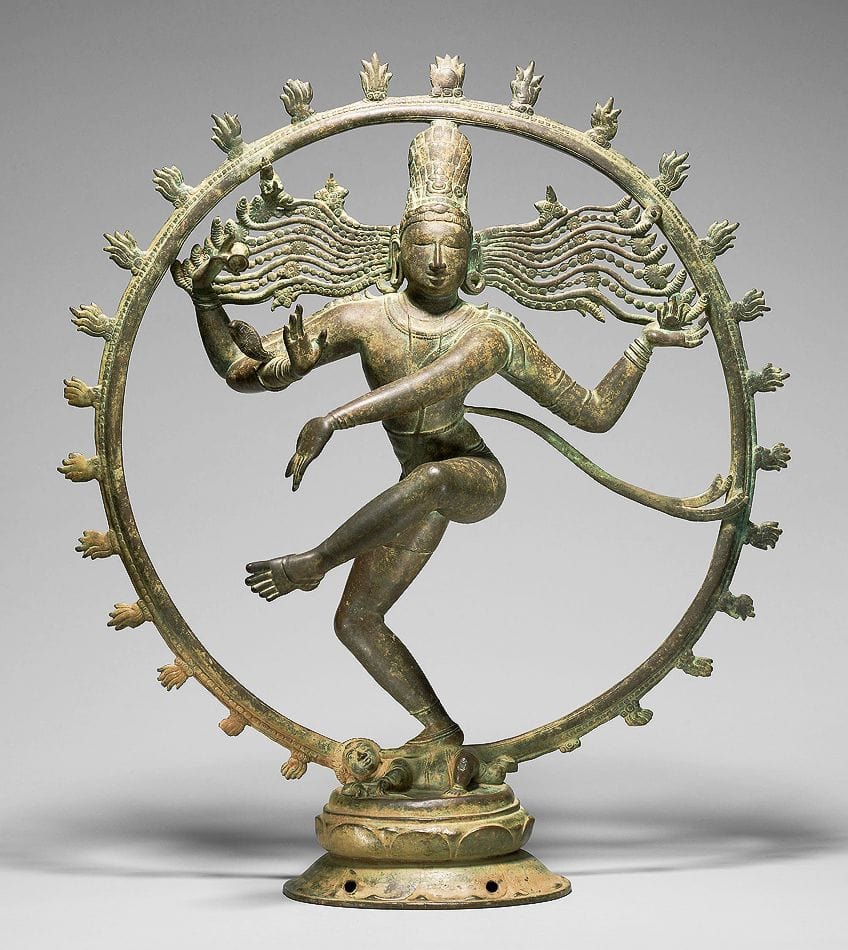
Other designs included animal motifs, Gods, goddesses, and refined detailing. The most famous examples of Indian sculpture can be seen in the rock-cut works at Ellora and Ajanta, as well as the Gupta-era sculptures and monolithic statues of the Great Buddha and Sarnath.
Silver Filigree
Silver filigree was a delicate art form that originated in ancient India and involves the shaping and soldering of thin silver wires into elaborate motifs and artworks.
This art form required skilled artisans who used specialized tools to achieve remarkable precision and detail in their designs.
Artists who worked in silver filigree incorporated many symbols such as the lotus flower, which represented divine beauty and purity as well as the peacock for immortality and geometric patterns to symbolize cosmic order. The practice of silver filigree continues to hold a significant place in Indian culture and the creation of religious objects, decorative items, and jewelry.

Jewelry Making
The tradition of jewelry making was an art form that incorporated many techniques, including silver filigree. Jewelry produced in ancient India was produced using a wide range of materials such as precious gemstones, pearls, enamel, and precious metals like gold and silver. Techniques such as stone setting, enameling, and granulation were also used to create stunning pieces of jewelry that can be seen in their most exquisite form in pieces from the Indus Valley Civilization.
Jewelry included bangles, necklaces, and earrings with popular archaeological finds from the Gupta period, which demonstrated fine workmanship, and a special piece known as the Rajatarnam necklace, which featured meticulous detailing on the gold beads.
Kundan jewelry is also famous for its opulent designs, which incorporated gemstones and glass, and was popular during the Mughal period. The image of the dancing Shiva on the iconic Nataraja pendant is also a treasure of ancient India that showcases the styles of jewelry designers. Notable archaeological finds in ancient Indian jewelry include pieces from the Sree Padmanabhaswamy Temple in Kerala, which contain gold and gemstone-encrusted adornments.
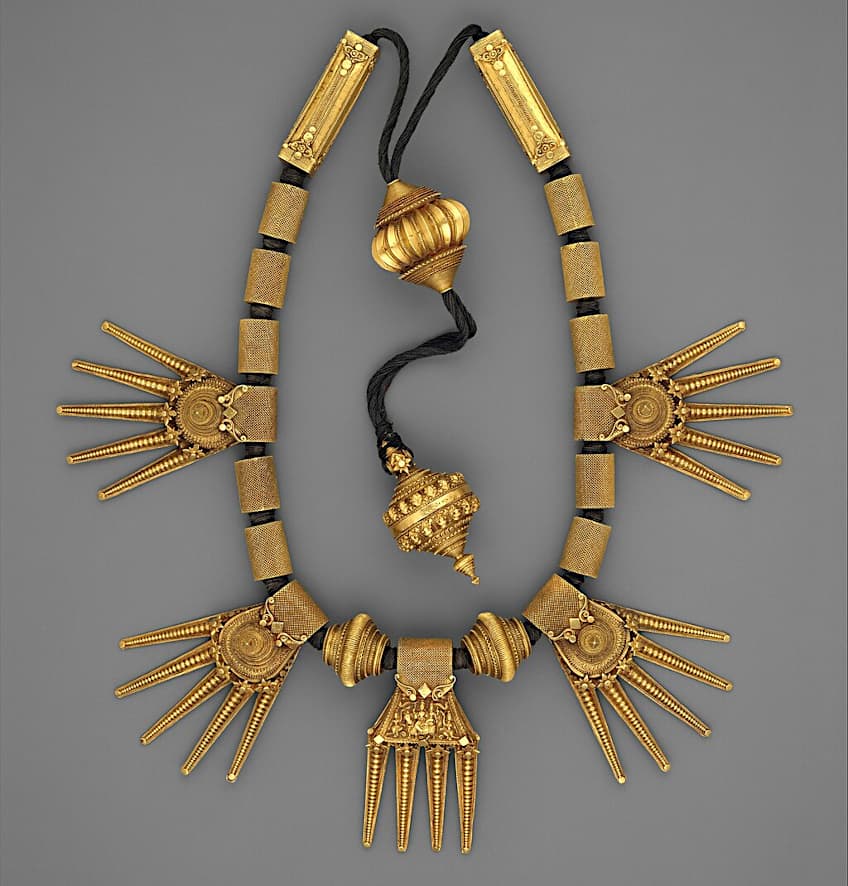
Dance
The art of dance is perhaps the most significant art form from ancient India that is still widely practiced through traditional dances today. Dance in ancient India was not only a form of artistic expression, but it was also an expression of religious devotion, social unity, and storytelling. Dances were organized and performed at religious events and royal gatherings in the courtyards of important patrons. Many Indian classical dances such as the Bharatanatyam, Kathak, Odissi, and Manipuri styles emerged in ancient Indian culture.
Dances like the Bharatanatyam originated in temples and conveyed stories from Hindu mythology while emphasizing expressive hand gestures and graceful footwork.
Popular dance styles like the Kathak dance are rooted in the Mughal courts and fuse the elements of Hindu and Persian traditions. This complex dance, and many others, are forms of storytelling that use gesture and expression to express the people’s devotion to their deities. The Manipuri dance is a variation that uses delicate movements and narratives from Manipuri mythology.
Architecture
Ancient Indian architecture saw a remarkable development in unison with the visual arts, which incorporated elements of culture, religion, and historical influences. Some of the notable architectural styles included the early Buddhist rock-cut caves in Ajanta and Ellora as well as temple architecture of the Gupta period through iconic structures like the Vishnu temple at Deogarh.
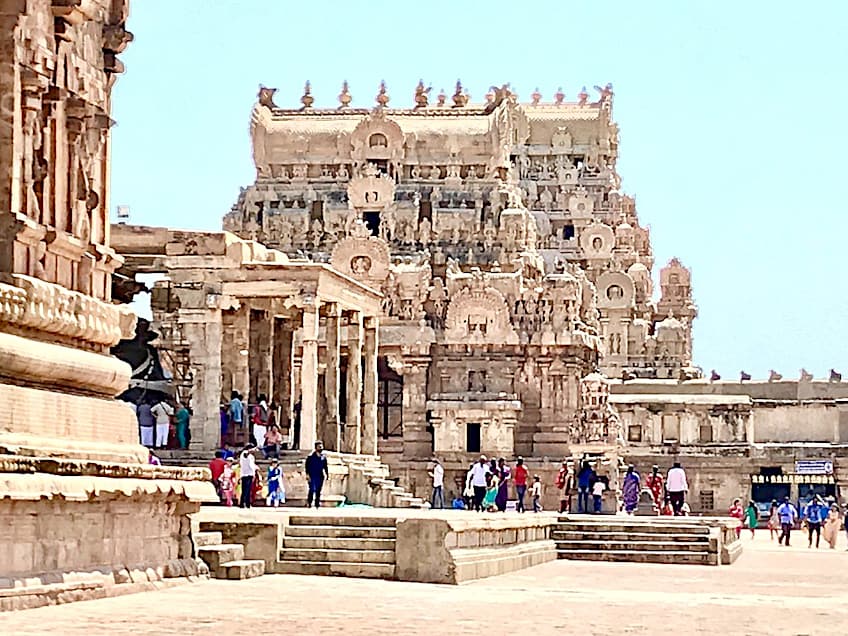
The Chola dynasty produced some of the most well-executed structures, which can be seen in the design of the Brihadeeswarar Temple in Thanjavur. The Mughal era marked a fusion of Islamic and Indian styles, which is immortalized in the architectural masterpiece, of the Taj Mahal, and the Red Fort.
Famous architects like Vishvakarman and Vishnudharmottara contributed significantly to shaping the architectural landscape of the Indian subcontinent.
Temples such as the Shore temple in Mamallapuram were also built by the Pallava dynasty and were a symbol of early Hindu architecture. The Shore temple with its monolithic rock relief and spectacular sculptures of deities is a prime example of Hindu architecture. The Chola leaders who took over the Pallava dynasty pursued the arts vigorously and are celebrated for their temple designs, which are also recognized as UNESCO Heritage sites.
Cultural and Religious Influences on Indian Art
In Indian art history, art has seen significant influences from culture and religion. Indian art has placed a diverse range of religious and philosophical beliefs at the forefront of its visual language, which incorporates select religious narratives from Hinduism, Buddhism, Jainism, and Islam. Jain art, for example, focuses on themes such as spiritual purity and non-violence while Hindu-inspired art explores the lives of various Gods and goddesses.
Influences from Islamic art also saw the use of intricate style in calligraphy and geometric design.
Different regions in India carry unique styles and traditions that played a role in shaping the regional variations in sculpture, painting, and design. Art found in Rajasthan is characterized by its use of intricate details and bold colors, which were influenced by the Rajput and Mughal dynasties. South Indian art is focused on the exhibition of the Dravidian architectural style and detailed stone carvings found in temples.

India’s history in trade and cultural exchange also shaped the development of art styles since foreign influences affected various civilizations. The arrival of the central Asians, Persians, and Greeks also introduced new artistic techniques and designs that inspired Indian art.
Since the Mughals came from Central Asia, art elements from Persia and Islamic societies also moved into the country, which resulted in unique Indian art styles illustrating a fusion of Persian and Indian designs.
Socio-political changes documented in the rise and fall of empires in Indian history also shaped the development of art since wealthy merchants offered art opportunities to talented individuals to express their creativity.
Examining Art from India
Now that you have a deeper understanding of the aspects that influenced Indian art, you can now review some of the most famous masterpieces and paintings by Indian artists from the past. The creative expanse of the artists from the Silk Road and the influences of trade helped conjure up some of the most stunning and elegant pieces of art you will see below.
Krishna Killing the Horse Demon Keshi (c. 5th Century CE)
| Artist Name | Unknown |
| Date | 5th century CE |
| Medium | Terracotta |
| Dimensions (cm) | 53.3 x 40.6 x 10.8 |
| Where It Is Housed | Metropolitan Museum of Art, New York City, United States |
This famous terracotta sculpture portrays the God Vishnu appearing as the avatar and warrior king Krishna who freed the people from demonic threats. The sculpture portrays a scene from the myth where Krishna slays the demon Keshi, who took the form of a horse.

The scene is believed to originate from Greek myth as illustrated in Hellenistic art, in which a similar story describes the efforts of Hercules who slays the man-eating mares of Diomedes. The sculpture remains an iconic symbol of the significance of early Indian Vedic practices, which involved the sacrifice of horses. The narrative of Krishna slaying Keshi is a popular theme that was also used in temple plaques as decoration.
The Ajanta Cave Paintings (c. 5th – 7th Century CE)
| Artist Name | Unknown |
| Date | c. 5th – 7th century CE |
| Medium | Fresco |
| Dimensions (cm) | Varied |
| Where It Is Housed | Ajanta, Aurangabad district, Maharashtra, India |
Since the 5th century CE, the Ajanta caves have received many visitors, including Buddhist pilgrims, traders, and monks who partook in creating the many rich and decorative paintings in the cave. These murals are among the most popular paintings by Indian artists that provide scholars with valuable information on the cultural interactions of the area at the time and portray figures of Sasanian merchants wearing bright blue socks and interacting in a trade deal. The fresco at Cave1 contains other figures dressed in garments from other regions and foreign lands, reflecting the multicultural society that thrived in the 5th century.

Images of colorful textile garments also feature in the paintings, which is evidence of the types of imported goods that occurred during the Gupta era. Other paintings found in the Ajanta caves include mandalas, monsters, Buddhas, and Bodhisattvas whose influence and presence on the Silk Road make them important historical traditions.
Some of the color pigments used in the paintings at Ajanta include variations of ochre in yellow, red, and brown as well as lapis lazuli, white, and black, which were imported pigments from the Iranian Plateau and Central Asia.
Preaching Buddha (c. 8th Century CE)
| Artist Name | Unknown |
| Date | c. 8th century CE |
| Medium | Bronze with silver inlay |
| Dimensions (cm) | 21.3 (h) |
| Where It Is Housed | Metropolitan Museum of Art, New York City, United States |
This statue of Buddha is considered to be a unique and unconventional find in Indian history. The Buddha was sculpted in bronze in a complete yogic pose with his hands in a preaching gesture, which is a reference to the first sermon at Sarnath. The unknown artist behind the statue sculpted the Buddha with an unidentified style and complex treatment of his monastic robes as seen in their pleated ends.
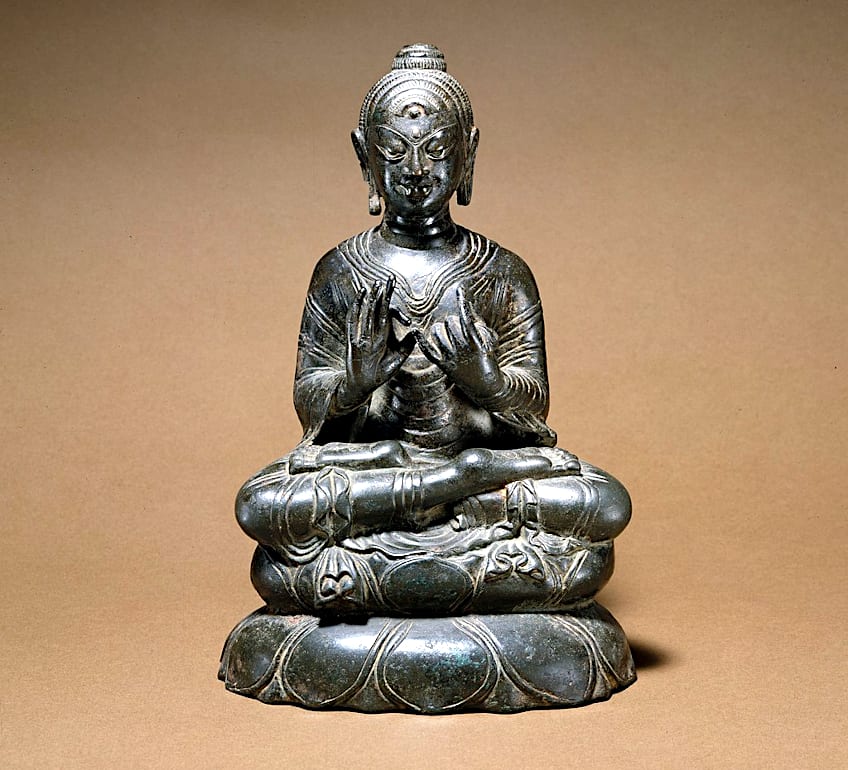
The style is believed to originate in the Swat Valley or Kashmir and is an iconic work housed at the Metropolitan Museum of Art in New York. Additionally, the bronze statue is also styled with silver inlays around the eyes and the urna marking on the forehead.
Another unique feature of the statue is that the Buddha’s hair curls and extremely stylized eyebrows and eyes are completely unconventional for other Buddha sculptures at the time, which makes this sculpture truly a fascinating find.
Prince Akbar and Noblemen Hawking, Accompanied by His Guardian Bairam Khan (c. 1555 – 1558)
| Artist Name | ‘Abd al-Samad (c. 1505/15 – 1600) |
| Date | c. 1555 – 1558 |
| Medium | Opaque watercolor and ink on paper |
| Dimensions (cm) | 36.2 x 24.3 |
| Where It Is Housed | Metropolitan Museum of Art, New York City, United States |
This historical painting was created by a court painter called Abd al-Samad who received his training at the atelier of Shah Tahmasp in Tabriz, where he also served as a court painter to the Mughal emperors Humayun and Akbar until his death. Abd al-Samad was appointed the tutor to the young Akbar and went on to become the court’s master painter, who taught many other aspiring court painters.
The artist was so talented in art and administration that he was later appointed to be the director of the royal mint at Fatehpur Sikri with many other senior governmental positions that followed.
This stylized and almost animated scene showcases Abd al-Samad’s eye for fine detail as he presents the youthful Akbar adorned with turban ornaments and heron-feather plumes. Akbar is portrayed engaging in hawking and has just made the first kill. The landscape was painted in a monochrome fashion while the rocks display influences from the Safavid style combined with Mughal Realism.
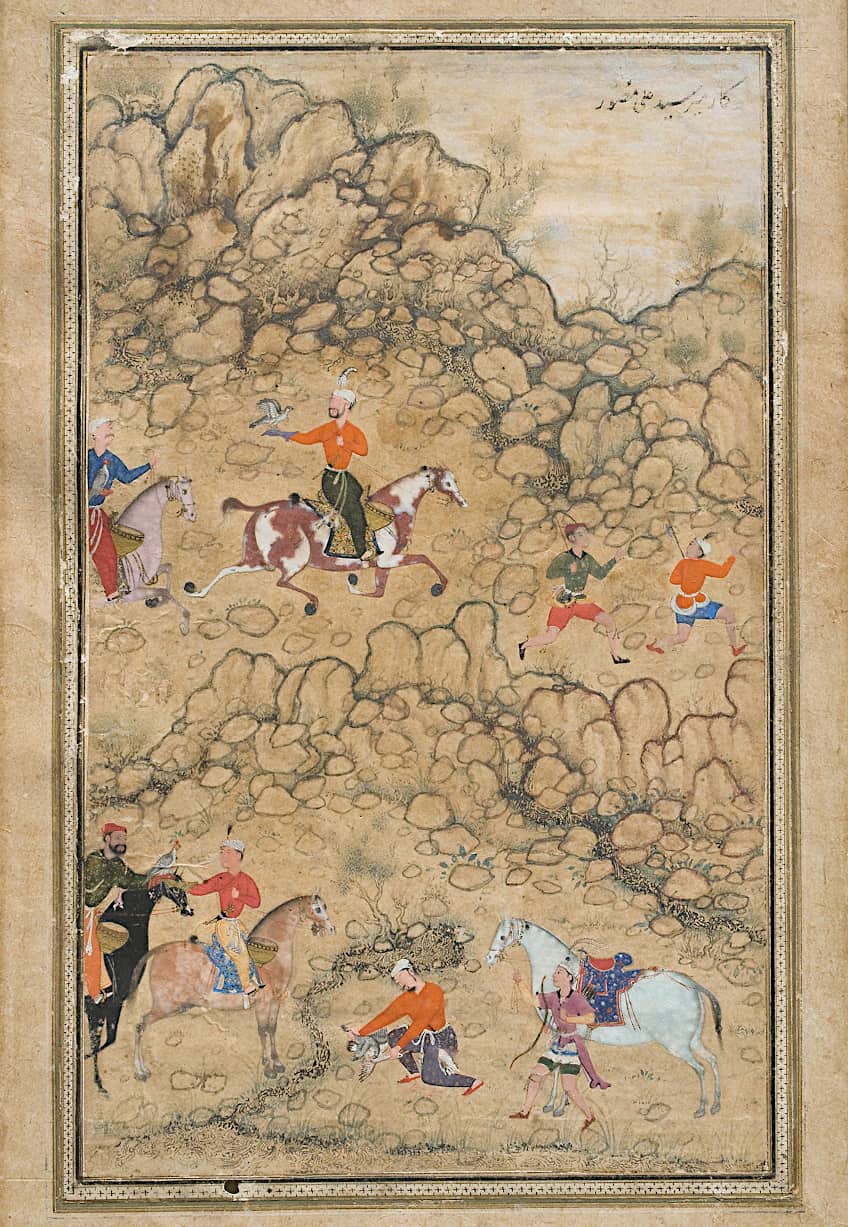
What makes the painting so special is that it is one of the rare examples of Mughal paintings from Delhi associated with the era of Humayun’s reign. The image is speculated to have been produced shortly after the Humayun’s recapture of Delhi and includes Prince Akbar with his guardian Bairam Khan. A year later, Prince Akbar became the emperor. The painting represents an independent work that stands apart from a manuscript and is among the earliest works of Abd al-Samad’s career.
Jahangir Watching an Elephant Fight (c. 1605)
| Artist Name | Farrukh Chela |
| Date | c. 1605 |
| Medium | Ink, opaque watercolor, and gold on paper |
| Dimensions (cm) | 47 x 32.7 |
| Where It Is Housed | Metropolitan Museum of Art, New York City, United States |
This brilliant decorative painting showcases a view of Indian king Jahangir on his royal steed alongside two men on elephants adorned in gold chains. The two elephants fight before Jahangir and his servants while one of the fighters drops his Ankush, the instrument used to control the elephant.

In ancient India, elephants were viewed as symbols of strength and power, especially in Mughal India, and were used in military campaigns, hunting activities, and sports. The historical painting was created by Farrukh Chela in the early 17th century and portrays Jahangir in rich colors and gold embellishments.
Portrait of William Fullerton of Rosemount (c. 1760 – 1764)
| Artist Name | Dip Chand |
| Date | c. 1760 – 1764 |
| Medium | Opaque watercolor on paper |
| Dimensions (cm) | 26.2 x 22.6 |
| Where It Is Housed | Victoria and Albert Museum, London, United Kingdom |
This delicate watercolor painting is speculated to be a portrait of an East India Company surgeon William Fullerton who joined the service in 1744. Fullerton was present at the conquest of Calcutta in 1756 and was the only Englishman to survive the war between the English and Mir Kasim of Murshidabad. During the 1760s, officials from the East India Company embraced aspects of royal Indian life, and like Fullerton, embraced Bengal as their new home.
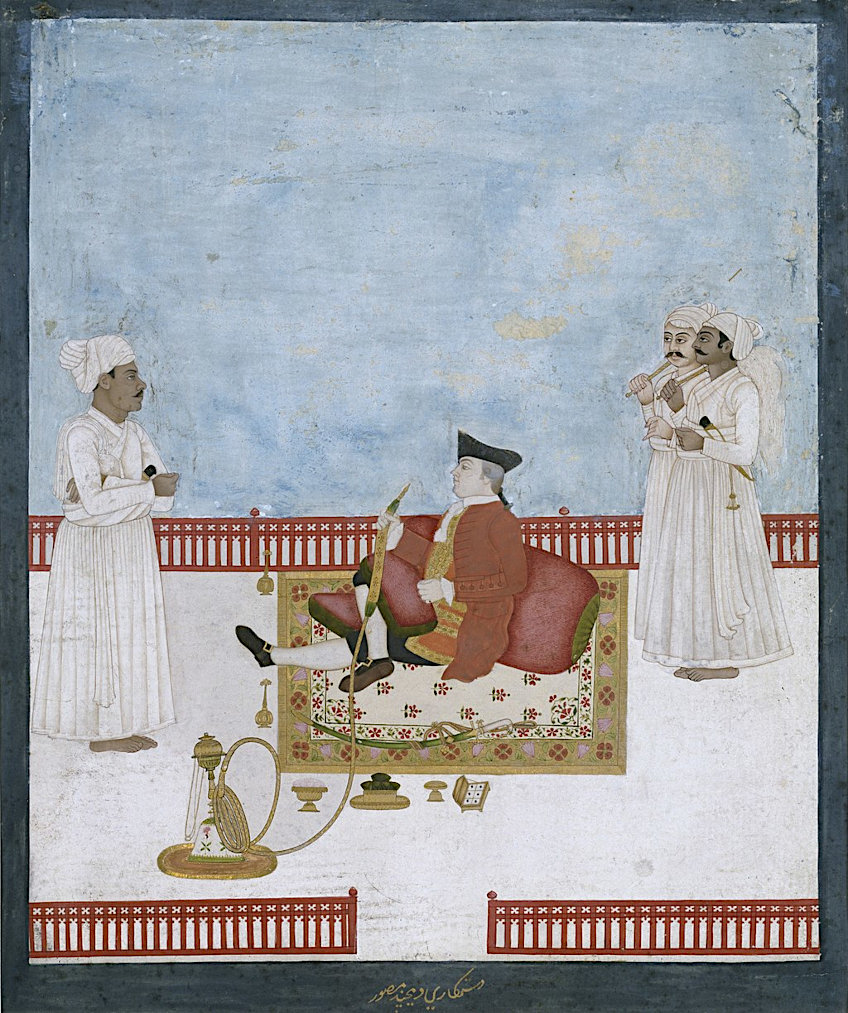
The portrait illustrates the official among servants who carry fly whisks called chauri and are seen receiving a visitor. He is seated on a luxurious carpet and appears to smoke a hookah. Included in the composition are also a betel nut box, rosewater sprinklers, and a sword, all of which are used to symbolize Indian royalty.
Fullerton was painted by an Indian artist known as Dip Chand, little of whom is known, who also portrayed Fullerton as an Indian prince. The reasons why Chand chose to do so are unclear, but his delicate and precise treatment of watercolor is something to marvel at.
Great Indian Fruit Bat (1777 – 1782)
| Artist Name | Bhawani Das |
| Date | c. 1777 – 1782 |
| Medium | Pencil, ink, and opaque watercolor on paper |
| Dimensions (cm) | 59.7 x 83.2 |
| Where It Is Housed | Metropolitan Museum of Art, New York City, United States |
Many early paintings by Indian artists are unnamed and often feature naturalistic elements, but none achieve such a refined level of Realism as this one. This highly detailed painting of an Indian fruit bat is attributed to a famous artist called Bhawani Das, who specialized in miniature painting. Scientifically known as Pteropus giganteus, the fruit bat is executed in remarkable detail, showcasing the creature’s fur, wings, claws, and eyes with a life-like quality. The naturalistic painting is speculated to have been created by a follower of Das if not the artist himself.
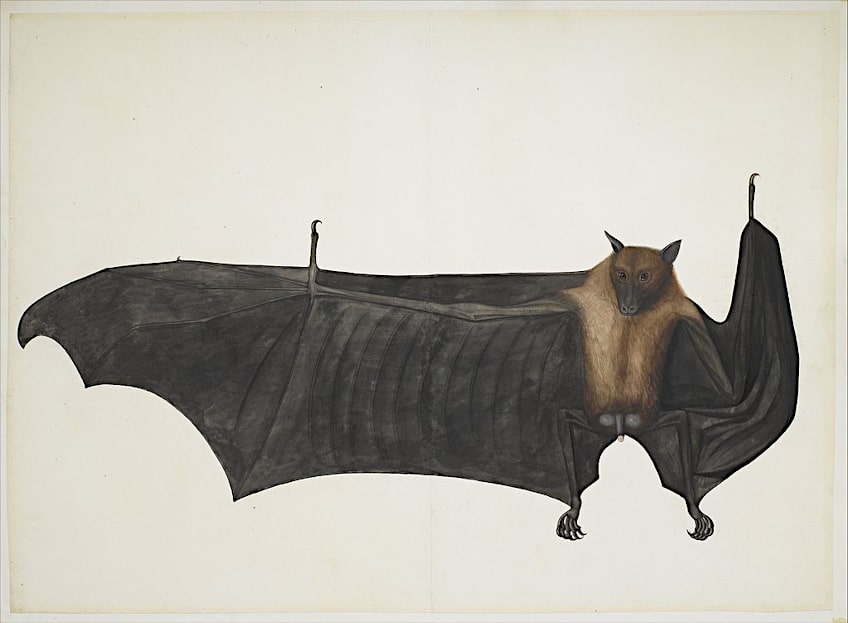
Famous Indian Artists
The above works represent a fraction of the hordes of artifacts and artworks available in the collections of many prestigious institutions around the world that store Indian artwork. Below, we will introduce you to a few famous Indian artists whose contributions to Indian art have proved highly influential.
Basāwan (Active c. 1556 – 1600)
| Artist Name | Basāwan |
| Date of Birth | c. 1556 |
| Date of Death | c. 1600 |
| Nationality | Indian |
| Medium | Painting |
| Associated Themes, Movements, and Styles | Mughal painting, miniature painting, portraiture, human nature, and Mughal Naturalism |
| Famous Artworks |
|
Basāwan was a talented painter and an important member of Akbar’s atelier in Delhi, who played a significant role in the creation of many major manuscripts. Basāwan received high praise from Abu’l Fazl for his excellence across composition and color, as well as his work in portraiture. Basāwan threw himself into developing new pictorial devices, which he studied in European art, and made his portraiture seem more naturalistic. His use of atmospheric perspective and painterly style can also be seen in his landscape works.
His notable contributions include his work on the Tutinama manuscript and the Hamzanama series, which demonstrated his ability to render rocks, trees, and portraits with remarkable naturalism.
Basāwan later fused Mughal styles with European approaches, which revolutionized the field of Mughal painting. His signature style when painting rocks and trees was also influenced by European styles since he also had access to Christian artworks and engravings, which broadened his repertoire.
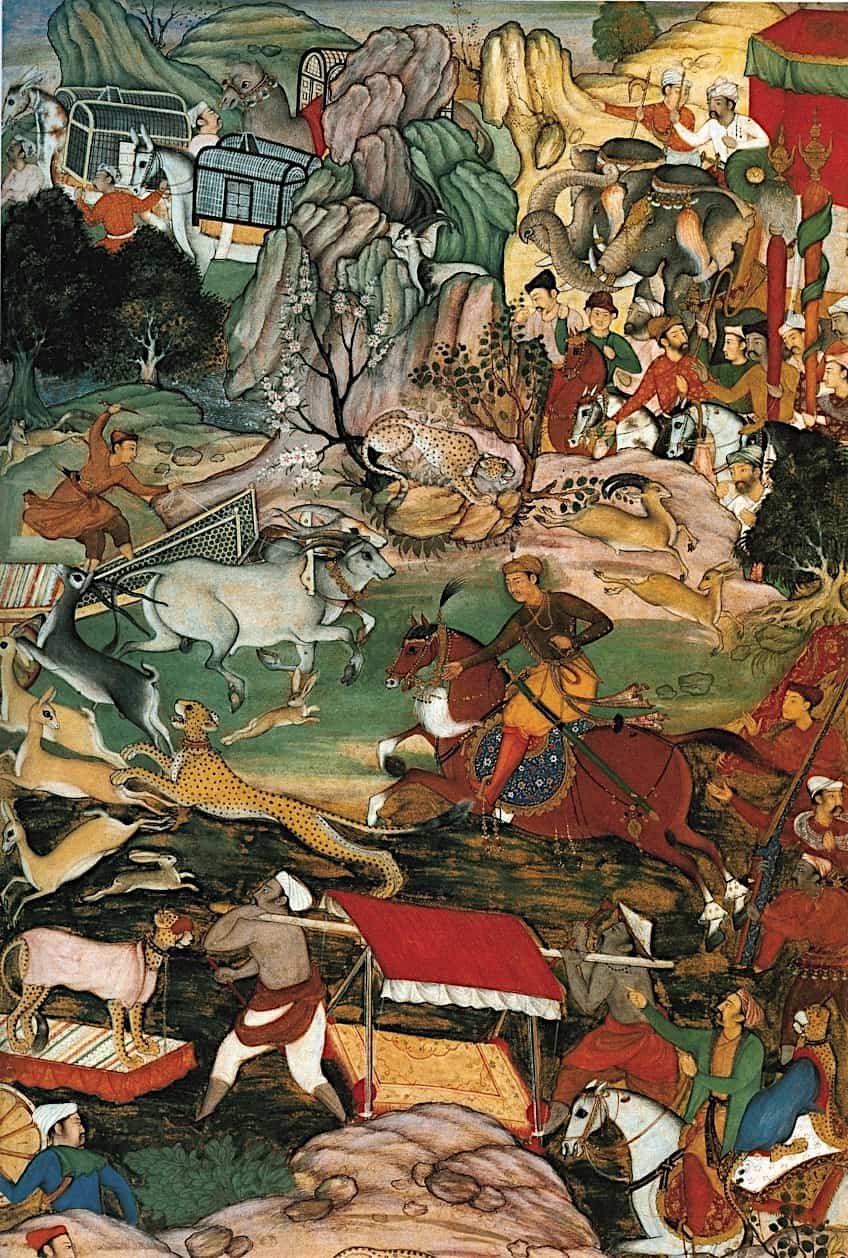
Keshav Das ( Active c. 1570 – 1604/5)
| Artist Name | Keshav Das |
| Date of Birth | c. 1570 |
| Date of Death | c. 1604/1605 |
| Nationality | Indian |
| Medium | Painting |
| Associated Themes, Movements, and Styles | Chiaroscuro technique, figurative art, portraiture, Mughal-European style, Christian iconography, and Mughal court painting |
| Famous Artworks |
|
Keshav Das was a prolific Hindu painter who also resided in Akbar’s atelier during the Mughal period. Das contributed significantly to many imperial volumes, including the Ramayana, where he demonstrated his skillful techniques in blending colors of the Indian palette and styles of the Timurid court. Keshav Das also explored European styles of painting and practiced them at the Mughal court.
Das was heavily influenced by Jesuit teachings and often studied Western engravings. His interpretations of European art led him to adopt and incorporate famous techniques such as the chiaroscuro method and perspective techniques.
Das’s innovative approach to painting and cultural fusion of art styles extended to portraiture, musculature studies, and landscape art, where he exercised his hand at tonal modeling and atmospheric effects. Das’ work was incredibly influential and did not go unnoticed in the Mughal court, which led him to produce numerous portraits in his unique style.
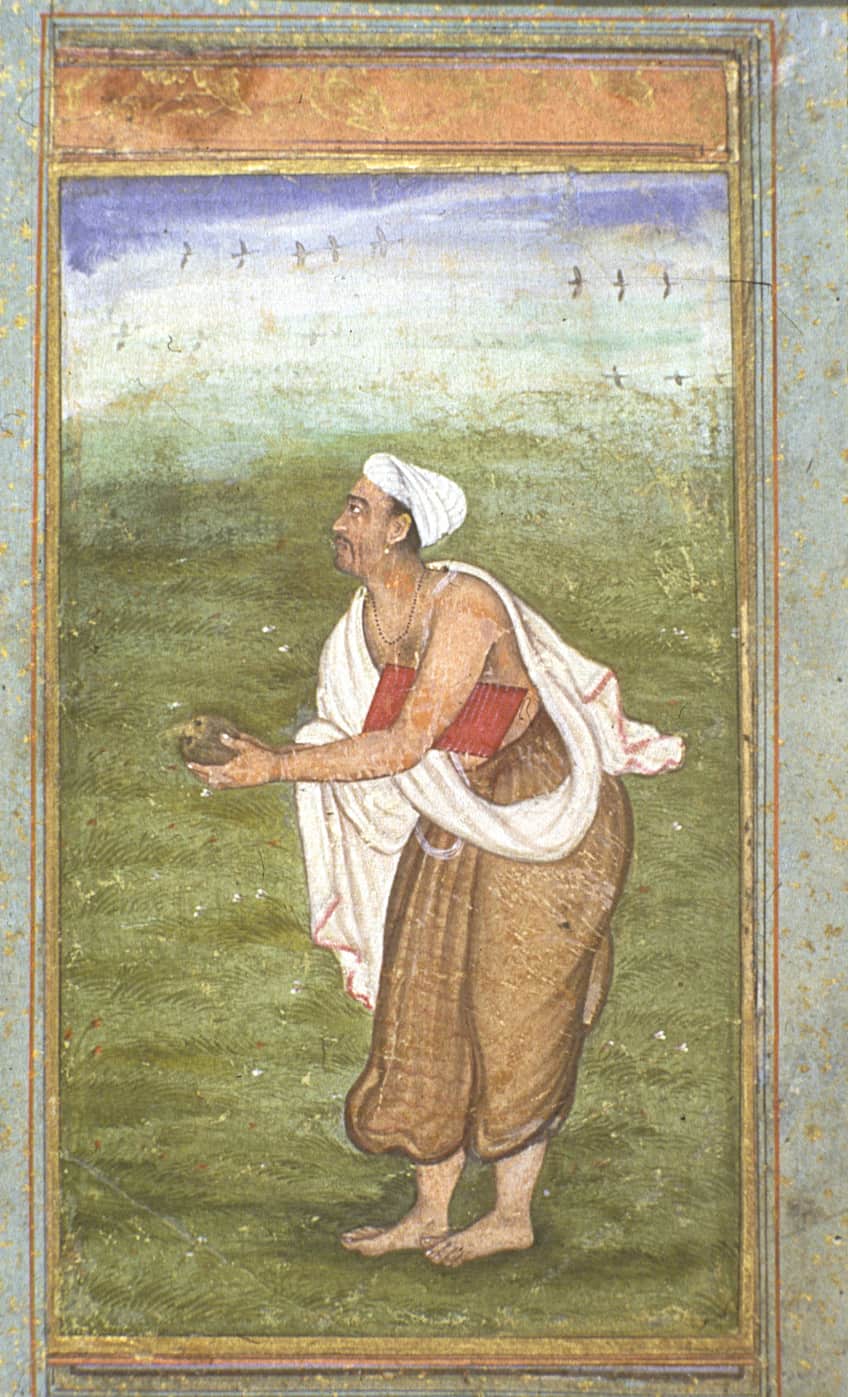
The Stipple Master (Active c. 1690 – 1715)
| Artist Name | The Stipple Master (unknown) |
| Date of Birth | c. 1690 |
| Date of Death | c. 1715 |
| Nationality | Indian |
| Mediums | Painting and drawing |
| Associated Themes, Movements, and Styles | Grisaille tonal drawing, nim qalam, and Mughal style |
| Famous Artworks |
|
The Stipple Master was a renowned anonymous Indian artist who emerged during the late 17th century. The legacy of the Stipple Master has left an indelible mark on the art scene of Udaipur, Rajasthan as showcased in his unique style defined by his monochromatic approach and his signature nim qalam technique. The unknown artist produced paintings for his patron, Maharana Amar Singh II, and depicted scenes of the ruler in different settings.
The artist often worked with a limited color palette with minimal colors to selected elements and figures to create compelling backgrounds.
The Stipple master’s influence on Indian art styles within the Udaipur community remains significant since his works provide insight into the artistic and cultural practices of the late 17th and early 18th centuries.
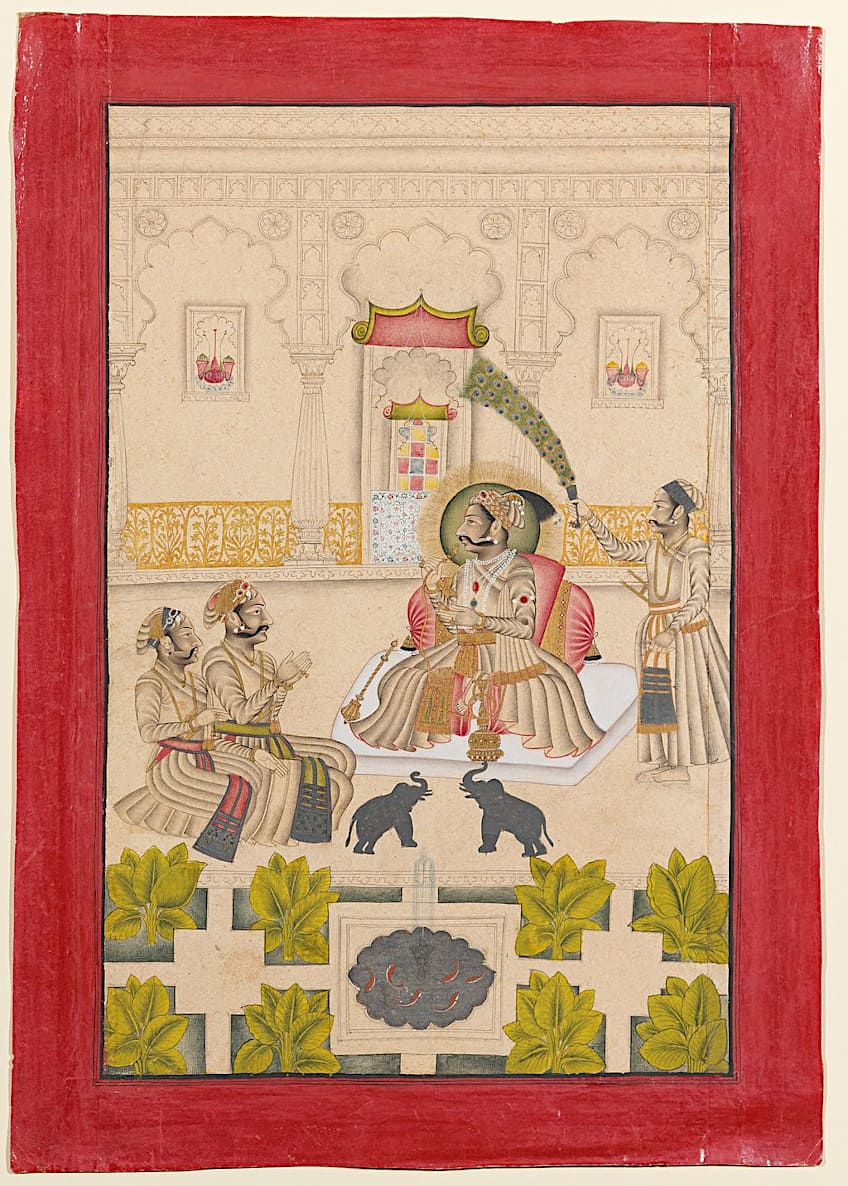
While not mentioned above, there are numerous iconic painters and sculptors in Indian art history whose unique stories and styles share the vast artistic landscape of the country and its complex cultural nuances. Artists such as Nainsukh, the Basohli Masters, Mansur, Bichitr, and the icons of recent centuries like Raja Ravi Varma, Amrita Sher-Gil, Rabindranath Tagore, Nandalal Bose, and Jamini Roy have all demonstrated how traditional Indian art has evolved through innovative art practices and cultural fusion.
Indian art has an incredibly diverse history that spans multiple art forms and art styles that are unique to the country’s cultures and religions. Traditional art has had a profound influence on the fusion of art styles seen in Modern and Contemporary art practices of Indian artists who draw from the stylistic approaches of the past. By understanding the early visual languages of the past, one can better appreciate the unique qualities of the numerous Contemporary Indian art styles of the present.
Frequently Asked Questions
What Is Indian Art?
Contemporary definitions of Indian art include the production of artworks and objects through art forms such as pottery, sculpture, early cave paintings, and textile art. Traditional Indian art was largely influenced by diasporic cultures and religions such as Hinduism, Jainism, Buddhism, Islam, and early Hellenistic values. Modern regions considered in Indian art history include India, Bangladesh, and Pakistan.
What Were the Common Art Forms in Ancient Indian Art?
The most famous art forms practiced in ancient India include painting, pottery, sculpture, architecture design, and textile arts like silk weaving.
What Is the Earliest Indian Artwork?
The oldest Indian artworks are considered to be the cave paintings of the Bhimbetka cave, which is located in Amchha Khurd, India, and are estimated to be around 30,000 years old.
Jordan Anthony is a Cape Town-based film photographer, curator, and arts writer. She holds a Bachelor of Art in Fine Arts from the University of the Witwatersrand, Johannesburg, where she explored themes like healing, identity, dreams, and intuitive creation in her Contemporary art practice. Jordan has collaborated with various local art institutions, including the KZNSA Gallery in Durban, the Turbine Art Fair, and the Wits Art Museum. Her photography focuses on abstract color manipulations, portraiture, candid shots, and urban landscapes. She’s intrigued by philosophy, memory, and esotericism, drawing inspiration from Surrealism, Fluxus, and ancient civilizations, as well as childhood influences and found objects. Jordan is working for artfilemagazine since 2022 and writes blog posts about art history and photography.
Learn more about Jordan Anthony and about us.
Cite this Article
Jordan, Anthony, “Indian Art – Spectacular Masterpieces from the Subcontinent.” artfilemagazine – Your Online Art Source. October 26, 2023. URL: https://artfilemagazine.com/indian-art/
Anthony, J. (2023, 26 October). Indian Art – Spectacular Masterpieces from the Subcontinent. artfilemagazine – Your Online Art Source. https://artfilemagazine.com/indian-art/
Anthony, Jordan. “Indian Art – Spectacular Masterpieces from the Subcontinent.” artfilemagazine – Your Online Art Source, October 26, 2023. https://artfilemagazine.com/indian-art/.


